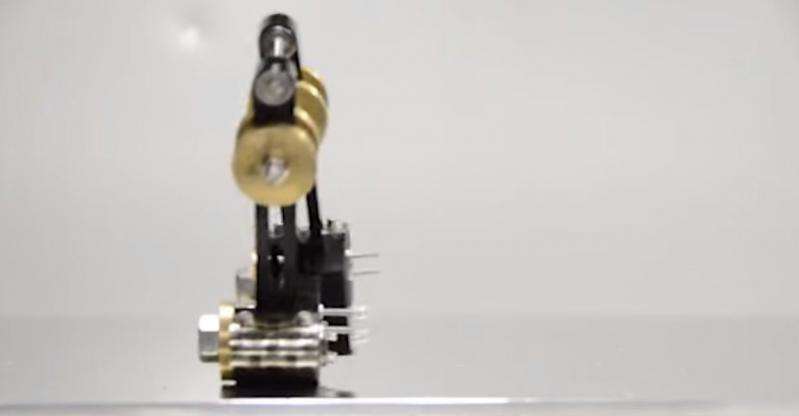October 7, 2015 weblog
IROS 2015: Thermobot feels the heat and walks (and walks)

Takeru Nemoto and Akio Yamamoto of University of Tokyo have presented a bipedal walking robot which is driven by constant heating. No sensors. No actuators, said Even Ackerman in IEEE Spectrum. Just a hot surface will do to get this robot walking. And once it starts to walk, he said, "it can keep going pretty much forever."
This is the Thermobot. Nemoto and Yamamoto said that in previous studies, self-oscillation powered by thermal deformation of bimetal was reported. An eccentric cylinder with a bimetal sheet automatically oscillates on a heated surface. The Thermobot team took the concept and converted the self-oscillation into bipedal walking.
On the robot's feet, bimetal sheets are attached. The leg swings in a traveling direction. By changing parameters, the gait can be controlled.
What do they mean by "bimetal"? This is not to be confused with an alloy where two metals are blended together; their design is different. Evan Ackerman noted the bimetal consists of two different kinds of metal stuck together, not blended. The two metals are layered on top of each other.
Popular Mechanics explained how this works, saying "two metals expand differently when they're heated. This deforms the feet. The researchers weighted the device's feet so that when one heats and deforms, it shifts backwards, and the way the robot's weighted makes the lifted foot shift forward. It's this constantly heating and cooling deformation process that powers its primitive location."
Gizmodo's Andrew Liszewski made the observation that, with Thermobot, "The walking motion requires everything to be perfectly calibrated—the weights, the curves of the feet, and the amount of metal deformation—but in theory the tiny robot could wander around a frying pan, or a grill, forever, as long as the heat is left on."
How hot is hot? Popular Mechanics said that the surface needs to be "pretty significantly hot. " IEEE Spectrum's header suggested the robot could walk in a frying pan forever. Thermobot in walking experiments walked on a hot plate that was 170 ◦C in a 26 ◦C room.
If you find it difficult to think up practical scenarios where the robot would be useful, you are not alone. Ackerman wrote, "We have to admit, though, that no practical applications immediately leap to mind. The researchers say that they're working on combinations of metals that will allow Thermobot to operate at much lower temperatures, perhaps even safe temperatures, and that it might make for a pretty cool toy."
Liszewski remarked that "the technique used for the locomotion could also be used to power other moving mechanisms without the need for batteries or power tethers."
Their work was presented recently at IROS 2015 (IEEE Robotic and Automation Society) in Germany. The authors stated in their paper that they were reporting on "a bipedal walker driven by constant heating, which walks on a heated horizontal surface."
They said the prototype has legs jointed to waist shaft and cylindrical feet with bottoms looped around by bimetal sheets. "When the prototype is placed on a horizontal surface heated at 170 ◦C, the bimetal sheets deformed to excite lateral swinging motion of the walker body and the walker successfully walked."
More information: "Thermobot: A Bipedal Walker Driven by Constant Heating," by Takeru Nemoto and Akio Yamamoto from The University of Tokyo, IROS 2015, Hamburg, Germany.
© 2015 Tech Xplore




















